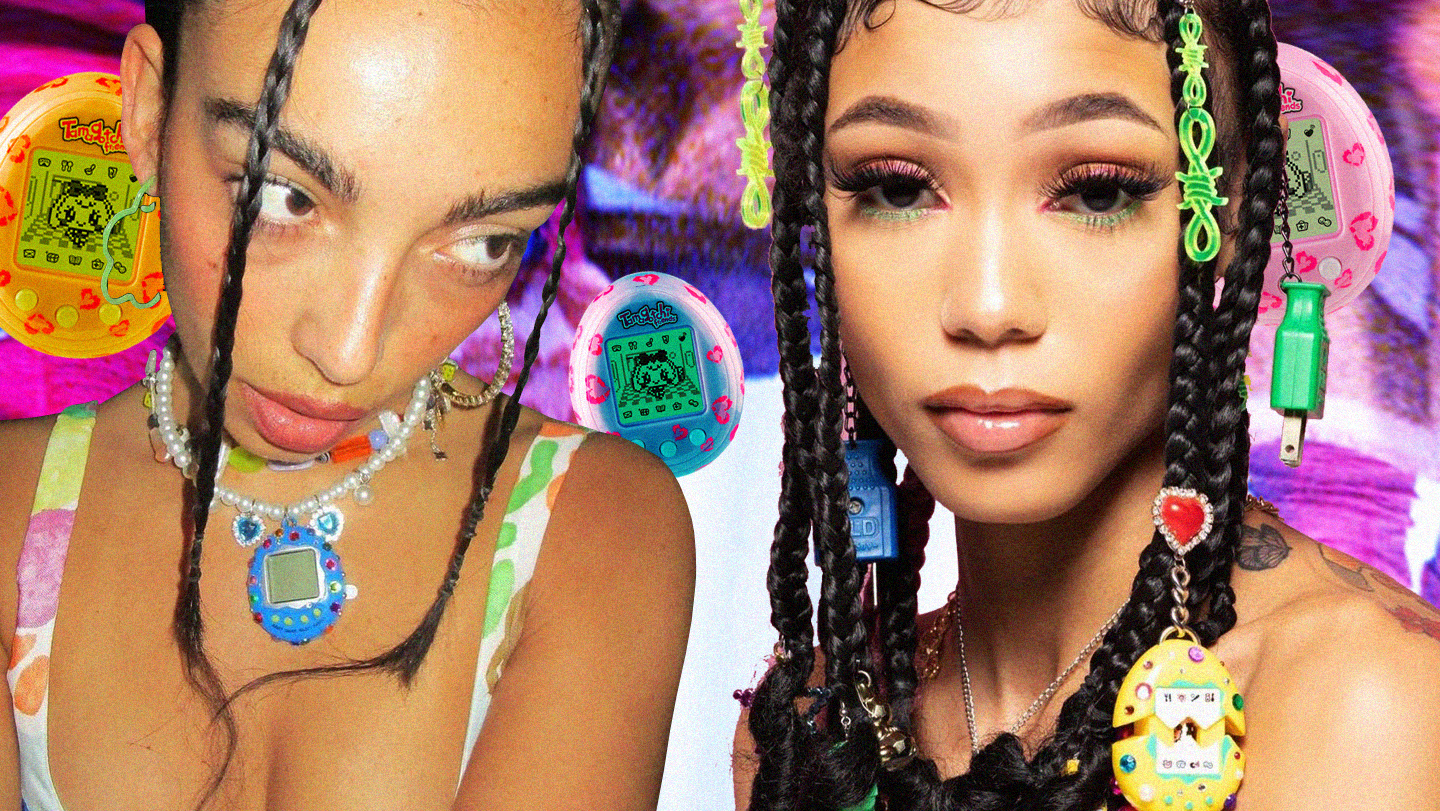Imagine a world in which your biggest worry is getting home from school on time to check up on your Tamagotchi. The words ‘metaverse’ and ‘blockchain’ don’t exist, Habbo Hotel is the social media platform, and your 10-pixel digital pet feels like the height of technological progress. It’s a simpler time. It makes sense then, that it’s one fashion is pining for once again.
This summer, Gen-Z’s obsession with the late nineties and early Y2K aesthetic reached new heights. From belt-size mini skirts at Miu Miu to the resurgence of cult brand Blumarine and Juicy Couture tracksuits everywhere you looked, the influence of the noughties began to trickle into other areas of life too. Wired headphones became cool again (albeit briefly). Everyone started to rediscover the low-pixel joy of digital cameras. And now nostalgic games are having a moment too. Clunky, obnoxious, and purposefully tacky, these deliberately outdated ‘techcessories’ are a tongue-in-cheek callback to an era synonymous with technological innovation.
People are wearing Nintendo game chips as earrings, taking Tamagotchis — which first launched 26 whole years ago — to functions, and embellishing outfits with deconstructed console screens. “It’s taking the most playful parts of the noughties and the parts that still resonate with us, and reimagining them,” says Samantha Hince, a trends forecaster based in London. “A lot of this trend is driven by TikTok – it’s driven by tech itself.”
Take fashion designer Myra Magdalen, from Alabama, whose maximalist outfits made from deconstructed noughties tech has earned her more than 20 million likes on TikTok. Posing in front of her signature backdrop of clunky computer keyboards, she wears an outfit adorned with a Rock Candy Xbox controller, squiggly coloured wires, and a spray-painted pink monitor. “I remember when I used to be anxious to use a computer, because it was so valuable at the time,” says Magdalen. “That same stuff is donated to thrift stores now, or going for nothing at the side of the road.”
While feeding into Gen Z’s environmentally conscious obsession with the resale market (a main factor behind the general trend of Y2K resurgence) repurposing old games in this way is in many ways a balm to the mind-boggling pace by which tech has evolved in recent years – as well as our never-ending appetite as consumers. With the arrival of the metaverse threatening our IRL lives with a fully virtual future, as well as phenomena like deep-fakes and AI-generated culture becoming something of a norm, it makes sense for us to want to look backwards at something more simple.
“I miss not having a smartphone that had everything on it,” says Magdalen. Back then, tech was compartmentalised – if you were lucky enough to afford them, you’d carry your iPod, Blackberry, Nikon Coolpix L15, and your Game Boy, all as separate items. It was more humble, and slightly less sinister. And since tech has wriggled its way into every area of our lives – burning us out and bombarding us with headlines – it just doesn’t feel as fun anymore. Even a leisurely game of Pokémon Go has the potential to be interrupted by a phone call from your ex.
“Everyone is looking for a certain level of escapism,” says Hince. “By being playful and not taking fashion too seriously, it adds a sense of novelty and lightness back into our lives.” In a way, the glitchy, kitsch, in-your-face aesthetic of nostalgic tech counteracts the glossy virtuality of the adult everyday. Take Laser Kitten, for example, whose upcycled game accessories have been seen on everyone from Coi Leray to Bella Hadid. Whether it’s Game Boy earrings, Etch-A-Sketch necklaces on freshwater pearl chains, or Swarovski-embellished vintage Tamagotchis, each piece is handmade by founder and creative director Marisa Ravel, and each, she says, sells out “almost instantly”. “When people see them, it sparks joy,” Marisa explains. “Things right now are really difficult in the world. It makes them remember a better time.”
As with many niches in the trend cycle — and this one has already reached the high street, inevitably, moving from Depop sellers turning toys into jewellery to Tamagotchi V5s being sold in Urban Outfitters — nostalgia is obviously central to the appeal. “Nostalgia is a bittersweet emotion,” says Dr Carolyn Mair, behavioural psychologist and author of The Psychology of Fashion. “Bitter because it’s in the past, and sweet because it reminds us of a time when the world was a better place (or so we believe).” It makes sense, then, that Instagram and TikTok accounts cataloguing vintage games have surged in popularity with tens of thousands of followers, and why we’re so excited to wear early tech as accessories. In uncertain times, we turn to the familiar.
Subscribe to i-D NEWSFLASH. A weekly newsletter delivered to your inbox on Fridays.
It’s likely we’ll see more of these sorts of items work their way into our wardrobes next year, with early tech’s influence filtering into SS23 runway collections. Jonathan Anderson for Loewe presented pixelated hooded sweats echoing the aesthetic of early MSN accounts; a step back by a few decades from his menswear collection which incorporated futuristic HD screens into garments. In a similar vein, the designer staged his JW Anderson SS23 show amongst the whirring slot machines of a neon-lit Soho arcade. Prints of stock screensaver-style images like palm trees and dolphins were blown up on handbags and tops, while oversized, random PC keys adorned dresses (for a DIY take, see creator Sara Camposarcone’s upcycled keyboard shirt).
The best thing about this trend is that it’s all just a bit of fun. The nature of the early tech aesthetic opens up endless creative possibilities for it to be interpreted in our wardrobes: the colours were bright, items were large and tangible, and these days, it’s instantly recognisable as being pre-social media. Time to start planning a trip home – if you’re lucky, your hottest new accessory might be one that’s already hiding in your parent’s attic.


